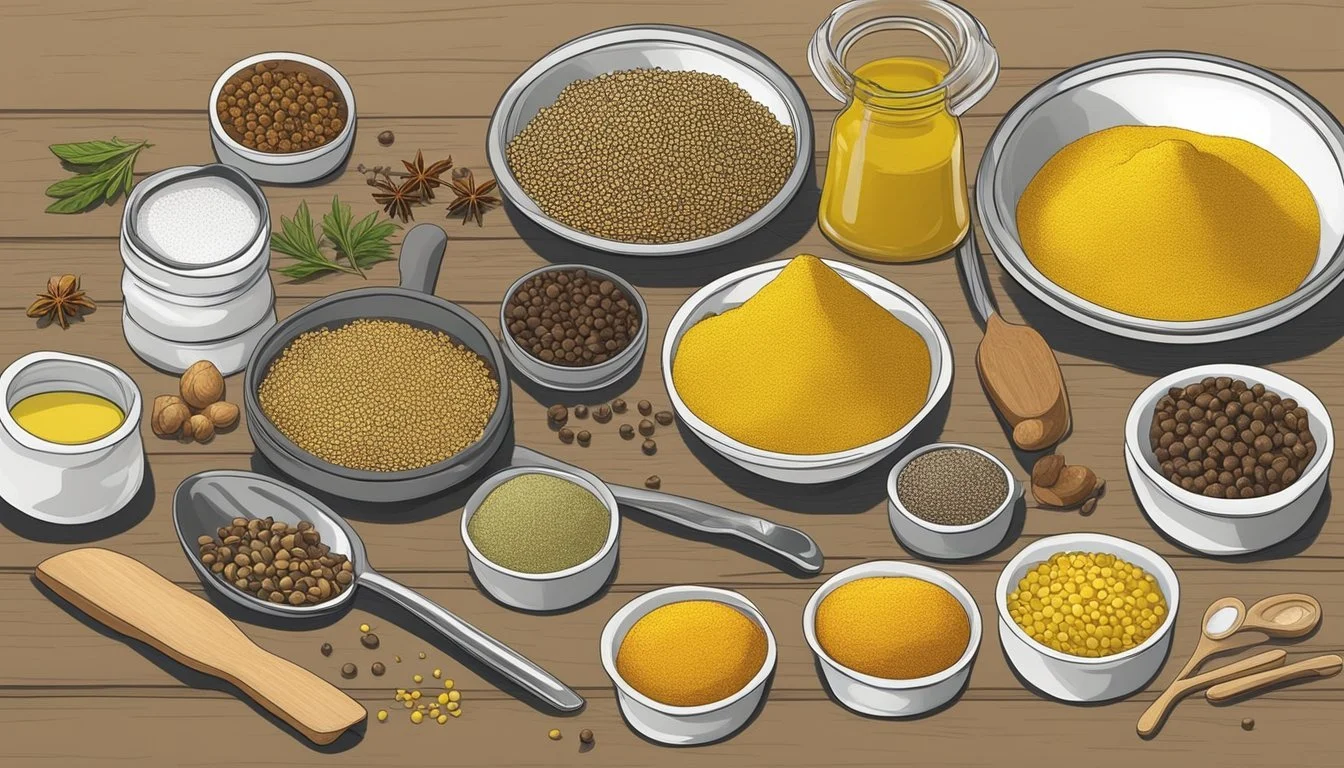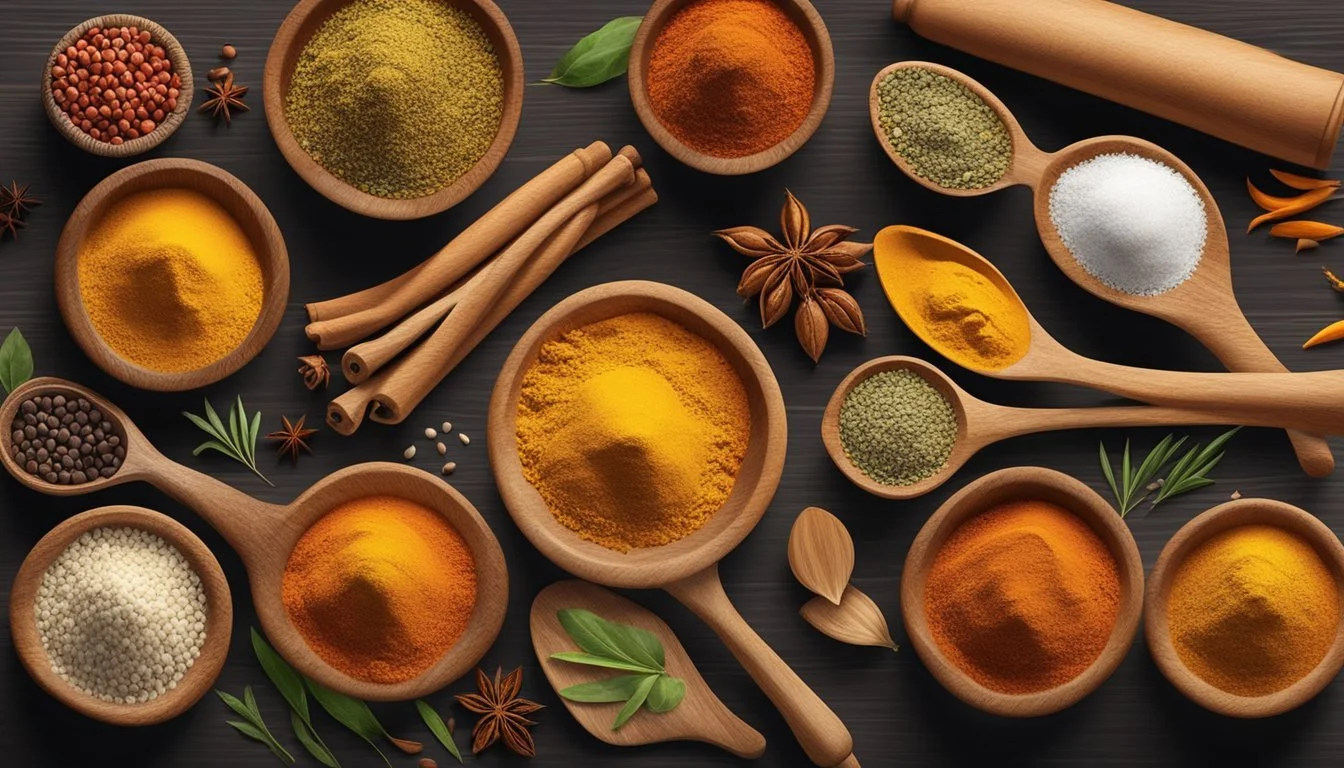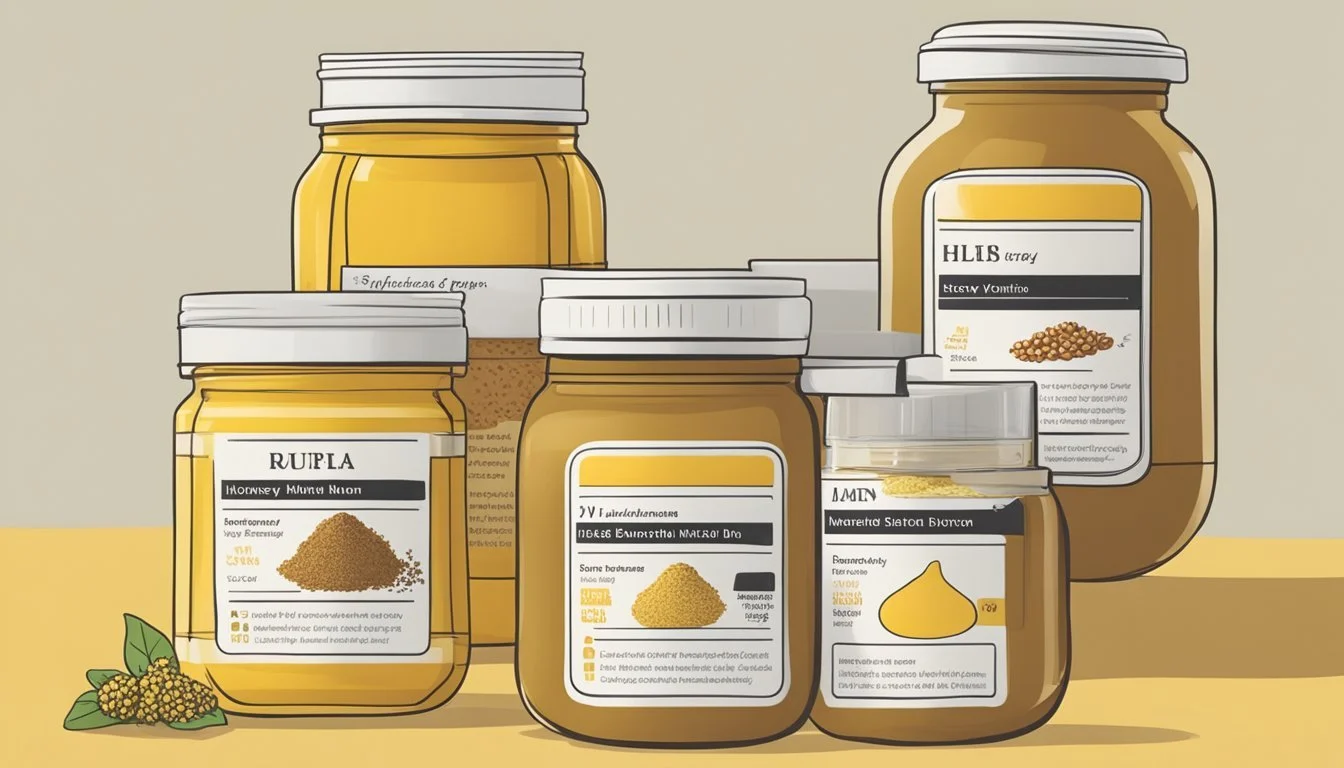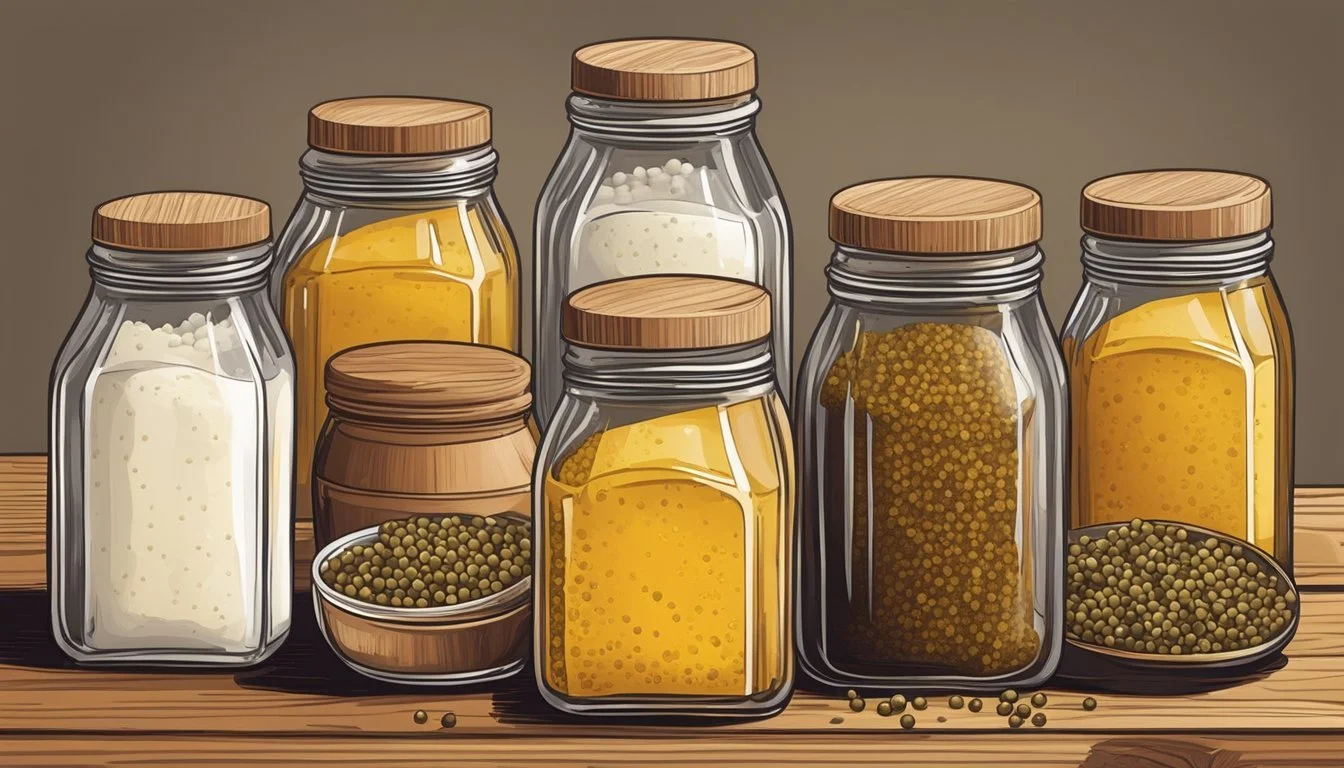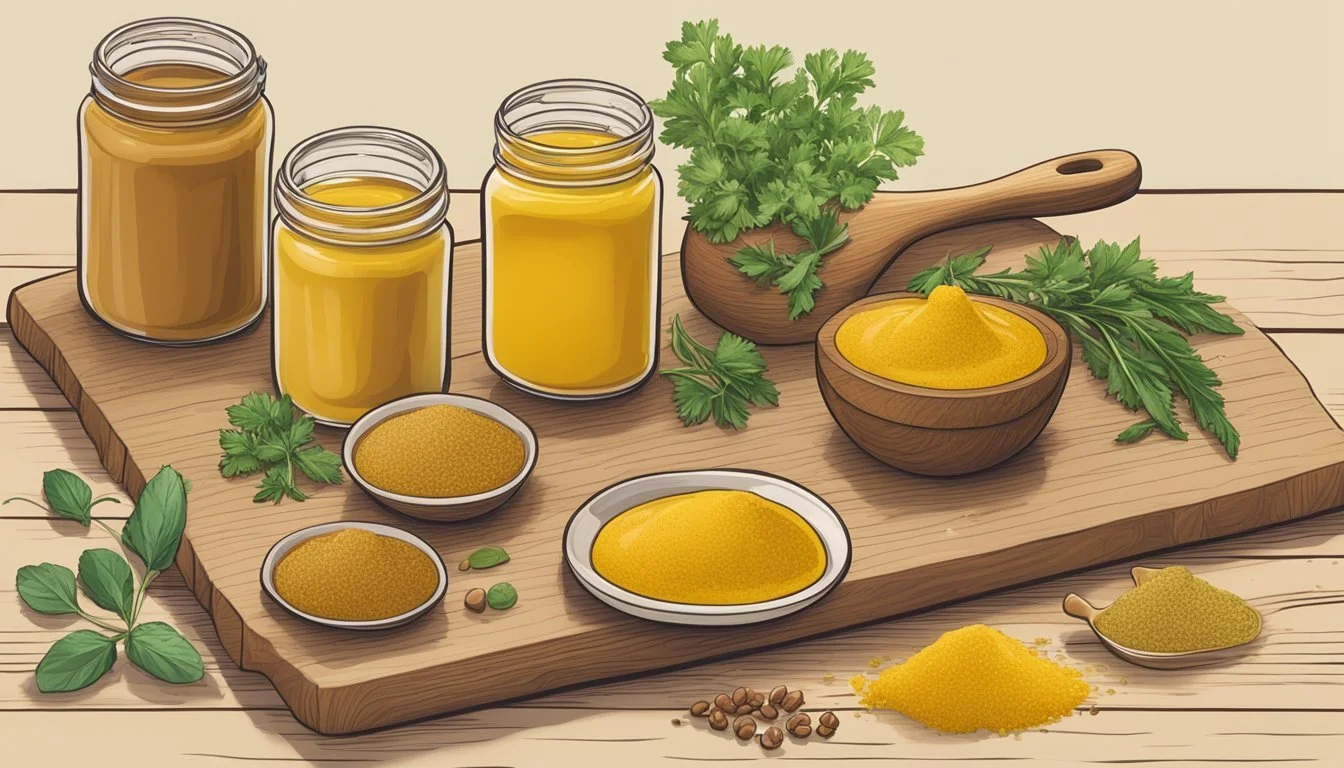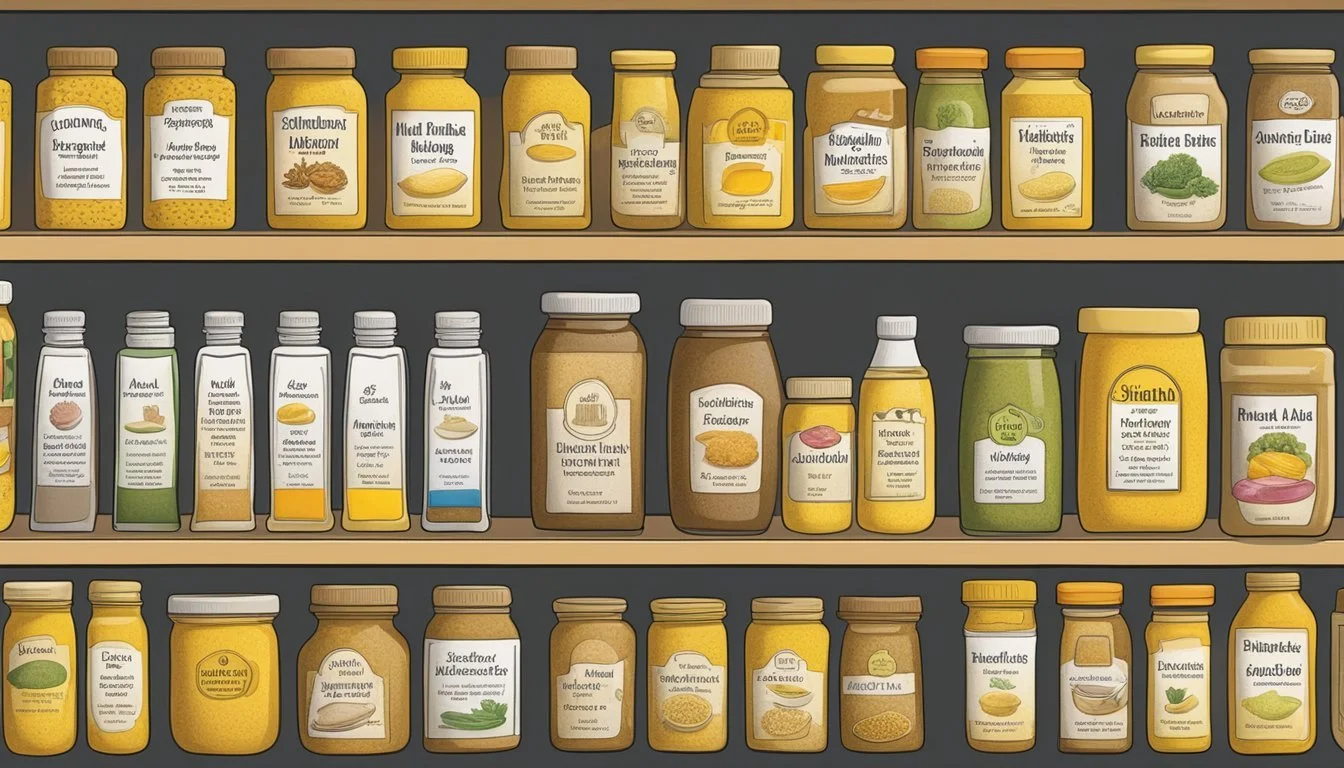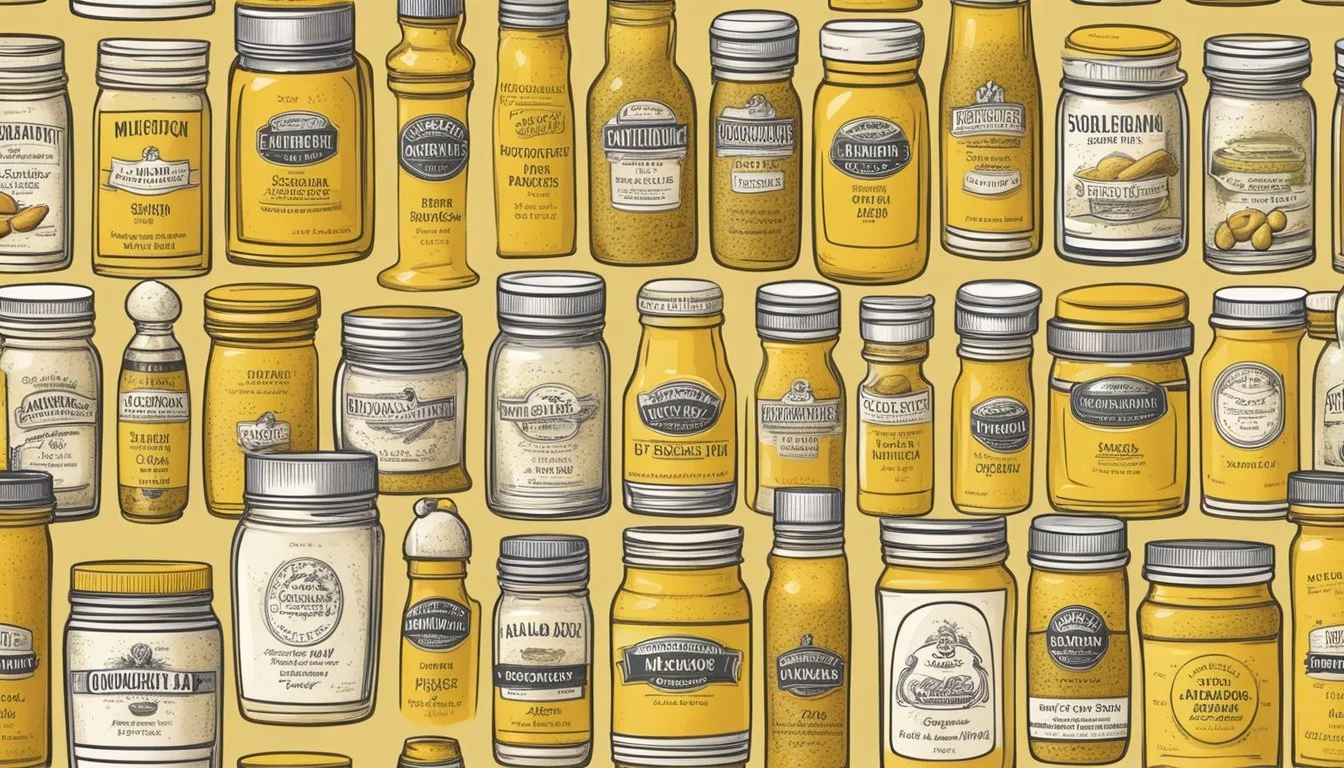American Mustard Substitutes
Top Alternatives for Your Recipes
American mustard, often referred to as yellow mustard, is a staple condiment in many households and dining establishments across the United States. Characterized by its bright yellow color and distinct tangy taste, it is commonly used to enhance the flavors of sandwiches, hot dogs, and burgers. The key ingredients in American mustard are a specific blend of ground yellow mustard seeds, vinegar, water, and spices like turmeric, which gives it its vibrant hue.
For various reasons, whether due to dietary restrictions, availability, or personal preference, one might seek alternatives to traditional American mustard. Fortunately, there are several substitutes that can mimic the typical flavor profile or serve the same culinary function. Mayonnaise, for instance, while different in taste, can replicate the creaminess and texture that mustard adds to dishes. In recipes where the sharp, piquant taste of mustard is required, horseradish or wasabi can be used sparingly to provide a similar heat and bite.
While the substitutes each bring their unique qualities to the table, they can serve as effective replacements in a pinch or to cater to different flavor preferences. Understanding these options ensures that culinary creativity is not hampered by the absence of American mustard, but rather enhanced by the use of resourceful alternatives that maintain the integrity of the dish's intended flavor experience.
Understanding Mustard and Its Role in American Cuisine
Mustard in the United States is not just a condiment; it's an integral component that complements a variety of dishes, from classic sandwiches to gourmet sauces.
Mustard Varieties
In the US, mustard primarily falls into a few key categories based on the flavor, ingredients, and preparation style. The most common is Yellow Mustard, typically bright yellow due to the addition of turmeric and made from a combination of yellow mustard seeds, vinegar, water, spices, and sometimes sugar or honey. Its flavor is mild and slightly tangy, often serving as a staple for hot dogs, sandwiches, and burgers. It is also utilized as a base for more complex sauces and dressings.
Other varieties include Dijon, honey mustard, stone-ground, and spicy brown mustard, each with its own distinct flavor profile and culinary applications. Dijon is known for its smooth consistency and sharp taste, often employed in more refined or creamy dishes. Stone-ground mustard, with a coarser texture and a bit of spice, can enhance the flavor of meats and cheeses.
Uses of Mustard in Cooking
American cuisine uses mustard primarily as a flavor enhancer and a binding agent. It's frequently slathered over sandwiches and hot dogs, bringing a tangy zest that balances out other rich flavors. However, it's also an unsung hero in salad dressings, marinades, and barbecue sauces where it adds acidity and helps emulsify ingredients, creating a cohesive blend of flavors and textures.
In cooking, mustard is versatile. It can be applied as a rub for meats to create a savory outer crust, whisked into vinaigrettes, or stirred into potato salad for an extra bite. Chefs often use mustard to add complexity to sauces, and it can be found incorporated into various dishes, offering a sharp contrast to sweetness or cutting through the fattiness of certain meats.
Choosing Mustard Substitutes
When selecting a substitute for American mustard, it's important to consider the desired flavor profile, texture, and potential health benefits to find a suitable alternative.
Based on Flavor Profiles
Tangy: White vinegar offers a tangy, acidic taste similar to mustard. Start with a small quantity and adjust to preference, as vinegar has a stronger flavor.
Pungent: Prepared horseradish or wasabi are pungent options that mimic the sharpness of mustard. Due to their intensity, one should use them sparingly.
Sweet: To replicate the sweetness of honey mustard, one can mix honey with a bit of yellow mustard in a 2:1 ratio, adjusting to taste.
Considering Texture and Consistency
For a thick, creamy consistency similar to mustard:
Mayonnaise works well in dressings and spreads.
It provides a milder flavor, so one may need to use more to achieve the desired taste profile.
For recipes that require the spice to be distributed evenly without altering texture:
Ground mustard seeds are an effective choice.
Yellow mustard seeds are milder, while black mustard seeds offer the most heat.
Looking at Health Benefits
Mustard, particularly when made from mustard seeds, is known for its health benefits, including anti-inflammatory properties. When choosing a substitute, consider:
Vinegar: It has zero calories and can promote digestive health.
Wasabi and horseradish: These contain compounds believed to have antimicrobial properties.
In recipes where health considerations are paramount, one may opt for alternatives with similar health profiles to mustard.
Popular Mustard Alternatives
When one runs out of American mustard or seeks a different taste profile, several alternatives can be utilized to maintain or complement the flavors in various dishes. These substitutes are often common household items which can be a convenient solution for those in a pinch.
Horseradish and Wasabi Options
Horseradish roots offer a fiery depth similar to mustard but with more intensity. It can be grated directly into dishes or used in a prepared form. Similarly, wasabi, the Japanese counterpart, provides a sharp, potent flavor ideal for replicating mustard's kick. Both should be used sparingly to prevent overpowering a dish.
Mayonnaise-Based Substitutions
For those wanting to mimic the creaminess of certain mustard types, mayonnaise serves as a viable substitute. It maintains the texture but imparts a milder taste. One can blend mayonnaise with a little vinegar or a pinch of turmeric for added zest and color that more closely resembles yellow mustard.
Vinegar Variations
Vinegar is another alternative, particularly white vinegar, which can substitute mustard in recipes requiring tanginess. The acidic nature of vinegar makes it suitable for dressings and marinades, though one should add it to dishes incrementally to achieve the desired balance of tartness.
Creating Sweet Replacements
For a sweeter mustard alternative, especially akin to honey mustard, one can combine a sweet element with a tangy base. Mixing honey with mayonnaise or a bit of plain yogurt can yield a condiment with a sweet and tart profile, perfect for salads and sandwiches.
Homemade Mustard Substitutes
Creating a mustard substitute at home can be approached through two methods: dry blends and wet mixes. These DIY alternatives harness readily available ingredients, such as ground mustard, spices, and liquids like vinegar or oil, to mimic the taste and texture of store-bought mustard.
DIY Dry Mustard Blends
Ingredients:
Ground mustard seed
Additional spices (optional)
Method:
Pure Ground Mustard: Use ground mustard seed directly as a dry mustard substitute. It has the pungent flavor and heat you would expect from mustard.
Spiced Mustard Powder: Mix ground mustard seed with a choice of spices such as turmeric for color or cayenne for heat. Start with a small amount of spice and adjust to taste.
Whisking Up Wet Mustard Mixes
Base Ingredients:
Ground mustard
Acid (e.g., vinegar)
Oil
Salt
Method:
Simple Mustard Paste: Combine equal parts water and ground mustard to form a basic paste. Add a pinch of salt for flavor enhancement.
Enhanced Mustard Paste:
Mix ground mustard with a chosen acid such as apple cider vinegar for tang.
Incorporate a teaspoon of oil for a smoother consistency.
Season with salt and a blend of spices to taste, like honey for sweetness or herbs for depth.
Remember to introduce ingredients gradually and taste as you go. Each homemade blend offers customization to suit specific palate preferences.
Spices and Seasonings as Alternatives
When traditional American mustard is not available, a cook can turn to various spices and seasonings to emulate its tangy, spicy flavor. The right combination of heat and tang can be achieved using individual spices or a blend for more complexity.
Single Spice Replacements
Horseradish: It offers a similar heat to mustard and can be potent. Users should begin with half the amount of mustard required and adjust to taste.
Garlic Powder: Milder than mustard but adds a pungent flavor. It is best used in cooked dishes.
Onion Powder: Imparts a subtle, slightly sweet flavor and works well in vinaigrettes and marinades.
Combining Flavors for Complexity
Cumin: Ground cumin provides a warm, earthy note that can partially substitute mustard's depth of flavor.
Paprika: This spice contributes a peppery note and can be used in conjunction with other spices to reach the desired complexity.
Black Pepper: Freshly ground black pepper can add piquancy, which complements other spices in creating a mustard-like flavor profile.
In summary, while no single spice fully replicates the flavor of American mustard, a combination of the aforementioned can provide an acceptable alternative in its absence. Experimentation is key, and taste adjustments should be made accordingly.
Specialty Mustard Substitutes
Specialty mustards, often influenced by global traditions or crafted by artisanal methods, offer unique flavors and textures. These substitutes are perfect for recipes that require specific taste profiles beyond the standard American mustard.
Global Flavors: Asian and European Influences
Asian and European cuisines provide a rich tapestry of mustard varieties that can be used as substitutes. For example:
Dijon Mustard: A classic French mustard with a sharp, tangy flavor, suitable for vinaigrettes and sauces.
English Mustard: Known for its robust and spicy taste, English mustard adds heat to dishes.
German Mustard: Comes in many forms, from sweet to spicy, with options like Bavarian sweet mustard or sharp, grainy Senf.
Whole Grain Mustard: This mustard, with its visible mustard seeds, offers a rustic texture and a pungent flavor, ideal for hearty meats and sandwiches.
Cuisine Mustard Type Flavor Profile Suggested Use Asian -- -- -- European Dijon Mustard Sharp, tangy Dressings, marinades European English Mustard Spicy, robust Roasts, sandwiches German Various (Sweet to Spicy) Varies Pretzels, wurst -- Whole Grain Mustard Pungent, grainy Charcuterie boards, sandwiches
Artisanal and Boutique Blends
Artisanal and boutique mustards often emphasize unique combinations and high-quality ingredients. They include:
Stone Ground Mustard: This mustard retains more of the mustard seed's flavor, which is ideal for those preferring a textured and earthy taste.
Ole Grain Mustard: Similar to whole grain mustards, ole grain variants complement gourmet dishes with their distinctive texture and taste.
Type Description Pairing Suggestions Stone Ground Mustard Textured, earthy Grilled meats, rustic breads Ole Grain Mustard Coarse, full-flavored Deli sandwiches, dressings
Substitutes for Specific Mustard Uses
When cooking or preparing food, American mustard can be replaced by a variety of other ingredients. These alternatives can depend on the dish being prepared, ranging from dressings and marinades to spreads and condiments. Each substitute provides a unique flavor profile and texture that can enhance the dish while maintaining a semblance to the original mustard-based recipe.
Substitutes in Dressings and Marinades
For salads and marinades requiring mustard's tang: White vinegar or apple cider vinegar can be used for their acidic and vinegary flavor. They should be added sparingly and to taste.
Enhancing meat: To infuse a spicy kick into marinades, especially for chicken or pork, prepared horseradish or wasabi are suitable substitutes with intensity, requiring minimal amounts.
Alternatives for Sandwich Spreads and Condiments
Sandwiches and burgers: Mayonnaise provides a creamy texture and mild flavor, making it an efficient alternative when mustard is unavailable. It can also be part of a condiment blend on roast beef or steak sandwiches.
Condiment base: Sour cream can serve as a mustard substitute in dips and as a condiment, with the addition of spices and herbs to tailor the flavor.
Suitable Substitutes for Recipes
Cooking with meat: When mustard is used as a spice in cooking meats like chicken or pork, one can use mustard seeds ground to taste, with yellow seeds being milder and black seeds being the spiciest.
In wet recipes: Prepared mustard is generally the best one-for-one substitute for dry mustard. Yellow mustard is preferable due to its balance of flavor and mild heat.
Nutritional Considerations of Mustard Substitutes
When selecting a mustard substitute, one should consider the nutritional profile and how it may differ from traditional American mustard. Mustard is known for its low calorie content and ability to add flavor without significantly altering the nutritional composition of a dish. It contains trace amounts of nutrients including calcium and antioxidants, while contributing minimal additional calories.
Mayonnaise is often suggested as a substitute to mimic the texture of mustard, but it is higher in calories and fat. Unlike mustard, mayonnaise lacks antioxidants and offers fewer health benefits associated with reducing inflammation.
Here is a comparison of the nutritional elements in common mustard substitutes:
Substitute Calories per Tbsp Fat (g) Fiber (g) Notable Nutrients Mayonnaise 90-100 10-12 0 - Horseradish <25 0.1 0.5 Vitamin C, Calcium White Vinegar 3 0 0 - Wasabi 15-35 0-1 0.2 Antioxidants
Alternatives like horseradish and wasabi contain fewer calories and offer antioxidants, which can contribute positively to one's health by potentially reducing inflammation. Horseradish also provides a small amount of dietary fiber and has calcium, making it a nutrient-dense option.
Conversely, white vinegar, another proposed substitute, provides the tang of mustard with nearly no calories or fat. However, it does not contribute significant amounts of fiber, antioxidants, or other nutrients.
Each option has its unique nutritional profile. One must balance the desired flavor outcome with the impact on the nutritional content of their meal. When substituting for mustard, it is important for an individual to consider how the replacement fits into their overall dietary needs and health goals.
Mustard Alternatives for Texture and Consistency
When considering mustard substitutes, one must be cognizant of the texture and consistency desired in the final dish. These properties can greatly influence the appearance, mouthfeel, and overall sensory experience.
Smooth vs. Coarse
Smooth Texture: For dishes that require a fine, smooth mustard consistency, mayonnaise or creamy salad dressings may serve as suitable substitutes. They lend a similar emulsified texture, with mayonnaise offering a more neutral base for adding additional seasonings if desired.
Substitutes for Smooth Mustard:
Mayonnaise
Creamy salad dressings (e.g., Ranch, Thousand Island)
Coarse Texture: When a recipe calls for whole-grain mustard, one is often seeking the grainy texture it provides. Candidates for this texture include stone-ground mustard, which, although slightly smoother, still contains partially ground mustard seeds.
Substitutes for Coarse Mustard:
Stone-ground mustard
Adjusting Acidity and Sharpness
The acid content in mustard contributes to its sharp flavor. Substitutes with a similar acidic profile, such as vinegars or citruses, can mimic this characteristic while maintaining the desired texture.
Substitutes for Acid and Sharpness:
White vinegar (use sparingly due to its potent acidity)
Lemon juice (for a milder tang)
One can also adjust the sharpness by adding a bit of sugar to milder substitutes, such as yellow mustard or honey mustard, balancing out their sweetness while tailoring the final flavor profile closer to that of Dijon mustard, known for its tangy sharpness.
Balancing with Sugar:
For a milder substitute: Add a pinch of sugar to yellow mustard.
For sweetness with sharpness: Blend honey with yellow mustard, starting with a 2:1 honey-to-mustard ratio and adjusting as necessary.
Recipes featuring Mustard Substitutes
Exploring the culinary versatility of mustard substitutes can be exciting, especially when one considers the variety of textures and flavors they can bring to classic and innovative recipes alike.
Classic Applications: Potato Salad and Deviled Eggs
In traditional potato salad, where mustard imparts a tangy flavor, one can utilize honey mustard to not only replace the tanginess but also add a subtle sweetness. A simple 1:1 substitution does the job while maintaining the desired consistency. For deviled eggs, a dash of white vinegar can be used alongside mayonnaise to mimic the zing without overpowering the delicate taste of the eggs. A combination of mayonnaise and a pinch of turmeric can also be an effective way to replicate the color and creaminess that mustard usually contributes.
Innovative Twists on Traditional Dishes
Inventive chefs might enjoy adding Sriracha to their barbecue sauce for a unique twist, combining the smoky sweetness of the sauce with the heat of Sriracha. Another creative option is incorporating wasabi or horseradish sauce into marinades to infuse meats with an intense, spicy depth that stands out in grilled dishes.
Condiments and Sauces
To craft a mustard-free condiment, a blend of ketchup and horseradish sauce offers a lively alternative with an ideal thickness for burgers or sandwiches. Those who appreciate a milder kick can mix a bit of honey with plain yogurt to create a creamy and slightly sweet "honey mustard" sauce. This ersatz honey mustard can be particularly useful as a salad dressing or as a dipping sauce.
Storing and Shelf Life of Mustard Substitutes
When considering mustard substitutes, proper storage is crucial for maintaining freshness and ensuring a longer shelf life. A commonly used condiment like mustard can be replaced with alternatives such as honey mustard, spicy brown mustard, or even a simple mix of mayonnaise and turmeric. However, the shelf life of these substitutes can vary.
Storage Tips for Mustard Substitutes:
Refrigeration: After opening, keeping substitutes in the refrigerator is recommended. This maintains quality by slowing down the degradation process.
Containers: Opaque containers prevent exposure to light, which can diminish a condiment's flavor and quality.
Sealing: To retain freshness and prevent contamination, ensure the lid or cap is tightly sealed.
Expected Shelf Life:
Unopened: Most mustard substitutes can last for quite some time unopened in the pantry, typically until the best by date.
Opened: Once opened and refrigerated, expect these substitutes to be at their best quality for 1 to 2 months.
Condition Shelf Life Unopened Up to best by date Opened (Fridge) 1-2 months (best quality)
Health Consideration:
Always inspect the condiment for signs of spoilage, like changes in color, texture, or odor before use, as spoiled products can be a health risk.
Remember, the quality of mustard substitutes can depreciate over time, but when stored correctly, they remain safe to consume well beyond the period where they retain optimal flavor.
Making Your Own Mustard Substitutes: Step-by-Step
Creating an American mustard substitute at home allows for fresh, customized flavors that can be tailored to one's liking. It involves choosing the right ingredients, mixing them to the desired consistency, and adjusting the flavors as needed.
Gathering Ingredients and Tools
One needs to collect:
Mustard seeds: Black for a strong punch, brown for sharpness, or yellow for mildness.
Liquid base: Options include vinegar (white, cider), wine, or for a slight twist, apple cider vinegar.
Additional spices: Depending on the desired flavor profile.
A good food processor or mortar and pestle to grind the seeds.
A simple table for ingredients:
Type Examples Notes Mustard Seeds Black, Brown, Yellow Black is hottest, yellow mildest. Liquid for Mixing Vinegar, Wine, Apple Cider Vinegar Apple cider vinegar adds a fruity twist. Additional Spices To taste Customizable to preference.
The Mixing Process
To begin making mustard:
Grind the mustard seeds using a food processor for a smooth paste or a mortar and pestle for a coarser texture.
Whisk in the chosen liquid gradually until a paste forms.
The proportions depend on the desired thickness; typically, one part seeds to one part liquid.
Customization and Flavor Tweaking
After the base mixture is set:
Personalize it by adding spices like turmeric for color, garlic powder for a kick, or sugar/honey for sweetness.
Adjusting the flavor balance may be needed, as homemade mustard can be more potent than store-bought versions. One should taste and add additional ingredients sparingly.
Variations can include adding herbs, horseradish, or even fruit purees for a unique take.
By following this guide, one can produce a mustard substitute that elevates any dish with tailored complexity and freshness.
Food Pairings and Complementing Flavors
When one is seeking substitutes for American mustard in a dish, considering the flavor profile and the food pairings becomes pivotal. A confident chef knows that the right mustard substitute not only mimics the original flavor but also marries well with the complementing flavors of the dish.
Salads: For dressings, one can utilize honey mustard—a blend of honey and yellow mustard. The sweetness of honey smooths out the pungency, making it a seamless match for leafy greens.
Salad Ingredients Mustard Substitute Leafy Greens Honey Mustard Potato Salad Mayonnaise* Coleslaw Yogurt or Sour Cream
*Mayonnaise can be enhanced by adding egg yolk and olive oil to thicken and enrich the flavor.
Sandwiches: Spread mayonnaise for a milder and creamier consistency. It complements cold cuts and cheeses without overpowering other ingredients.
Meat: Especially for marinades or glazes, select a substitute like Dijon mustard; it offers a balance of sharpness and heat that can penetrate and flavor meats effectively.
Turmeric: It's recognized for its bright color and earthy tone. Add a pinch to mimic mustard's color in dishes like dressings or egg fillings.
Dill: Fresh herbs such as dill can elevate mayonnaise-based replacements, providing a tangy and fresh undertone similar to that of mustard.
When employing these substitutes, chefs should be mindful of the intensity of flavors. For example, a little horseradish or wasabi goes a long way to provide heat. It is crucial to adjust quantities to one's taste preferences, diligently tasting and seasoning to achieve the intended flavor balance.
Health Benefits and Concerns with Substitutes
When considering various substitutes for American mustard in recipes or diets, one must weigh both the potential health benefits and concerns.
Health Benefits:
Antioxidants: Some mustard substitutes, like wasabi and horseradish, contain significant levels of antioxidants, which can help to protect the body against cell damage.
Fiber: Substitutes like whole grain mustard alternatives contribute dietary fiber to the diet, aiding in digestion and possibly reducing the risk of chronic disease.
Nutrients: Many mustard alternatives offer different vitamins and minerals. For instance, vinegar, a common substitute for the tangy taste of mustard, may help to regulate blood sugar levels.
Health Concerns:
Allergies: New substitutes may introduce allergens into a diet. It is crucial to check for ingredients like horseradish and wasabi, which could trigger allergic reactions in some individuals.
Inflammation: While some replacements can offer anti-inflammatory benefits, others might aggravate inflammatory conditions. One should be aware of personal sensitivities to components in these substitutes.
Dietary Restrictions: For individuals with dietary restrictions, it’s important to vet substitutes for compatibility with gluten-free, vegan, or other specialized diets.
Table of Key Factors:
Substitute Allergen Potential Diet Compatibility Noteworthy Nutrients Wasabi High Generally good Antioxidants, Potassium Horseradish Medium Generally good Vitamin C, Fiber Vinegar Low Excellent - Whole Grain Types Low-Medium Varies Fiber, Essential Fatty Acids
Consumers should choose their mustard substitutes not only based on taste preference but also on any health benefits or restrictions they may have. They must consider the presence of additives or preservatives and select options that align with their nutritional goals while being mindful of any dietary constraints.
The Evolution of Mustard and Its Alternatives in Culinary Culture
The trajectory of mustard in culinary culture has seen it embraced as an indispensable condiment across various cuisines. Historically, mustard's roots reach back to ancient civilizations, with evidence of its use in Indian and Sumerian cultures dating to 3000 B.C., and later by the Greeks, Romans, and across medieval Europe. The seeds were ground and mixed with vinegar, creating a timeless pairing served with meats and cheeses, highlighting its gastronomic significance.
Culinary trends over the centuries have celebrated mustard as a versatile ingredient. It journeyed from European tradition to North American tables, where it evolved from an imported delicacy to a domestically produced staple. North American culinary adaptation saw the rise of the first commercial mustard mill in the 20th century.
Transitioning from tradition to innovation, mustard has had an array of substitutes that cater to diverse preferences and dietary requirements. These alternatives include:
Mayonnaise: for a creamy texture
Horseradish: to maintain a spicy kick
Turmeric: as a dry substitute, offering vibrant color and health benefits
Wasabi or hot sauce: for an intense heat variation
The substitutes reflect an understanding of mustard's intrinsic flavor profile and its function in culinary applications. Cultural significance is also a key driver behind the need for alternatives, with choices that align with varying regional tastes while respecting the original’s place in culinary heritage.
Mustard’s journey illustrates its steadfast position in the world of flavors. Despite the surge of alternatives, mustard retains its status as a beloved condiment, symbolizing the dynamism of culinary culture and the continuous embrace of both tradition and innovation.
Conclusion
In the quest for culinary innovation, the discovery of apt mustard substitutes is a testament to the resourcefulness of cooks and chefs alike. An understanding of the flavor and texture profile of mustard enables one to navigate its absence skillfully.
When the classic tang and spice of mustard is missing in a pantry, white vinegar stands in with its acidic bite, though chefs should introduce this incrementally to avoid overpowering dishes. Mayonnaise offers a creamy texture and a milder taste, suitable for sandwiches and dressings. In respects to health, one must consider the substitute's nutritional profile; for instance, yogurt can provide probiotics while maintaining the creamy aspect.
Should a recipe call for a sharper, more pronounced heat, wasabi or horseradish becomes an effective stand-in, sharing a similar intensity with certain types of mustard. Dijon mustard, though milder, closely mimics the classic mustard flavor and can seamlessly substitute for American mustard in most recipes.
These alternatives not only salvage recipes but also open doors to creative cooking, allowing chefs to experiment with new combinations and flavors. They enrich the culinary toolkit, proving that even a common condiment like mustard can be skillfully replaced without sacrificing the integrity of a dish. The adaptability in using these substitutes reflects the growing trend of culinary innovation, where the familiarity of flavor meets the excitement of new textures and tastes.




